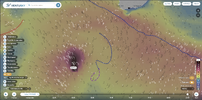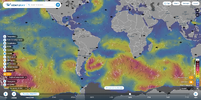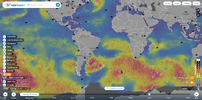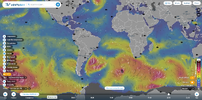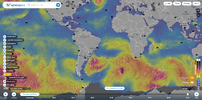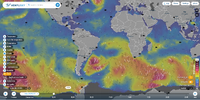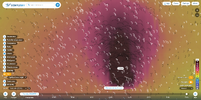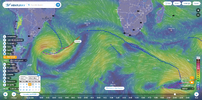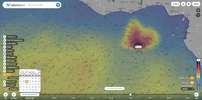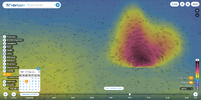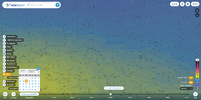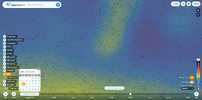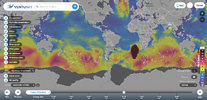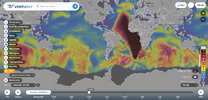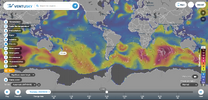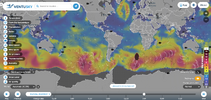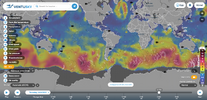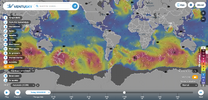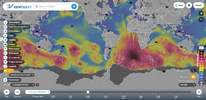Trying different parameter settings on Ventusky in attempt to explore the wave anomalies
If it was an outgassing, did any of the gasses they list show up in higher quantities? No, neither NO2 nor SO2 were higher, and they do not measure methane.
On Ventusky, there are wave settings. It turns out
the anomaly is counted as swell waves. Here is a screenshot.
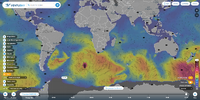
The Wiki for
Swell (ocean) begins:
A
swell, also sometimes referred to as
ground swell, in the context of an
ocean,
sea or
lake, is a series of
mechanical waves that propagate along the interface between water and air under the predominating influence of gravity, and thus are often referred to as
surface gravity waves. These surface gravity waves have their origin as
wind waves, but
are the consequence of dispersion of wind waves from distant weather systems, where wind blows for a duration of time over a fetch of water, and these waves move out from the source area at speeds that are a function of wave period and length. More
generally, a swell consists of wind-generated waves that are not greatly affected by the local wind at that time. Swell waves often have a relatively long wavelength, as short wavelength waves carry less energy and
dissipate faster, but this varies due to the size, strength, and duration of the weather system responsible for the swell and the size of the water body, and varies from event to event, and from the same event, over time. Occasionally, swells that are longer than 700m occur as a result of the most severe storms.
About their formation, they write:
Large breakers observed on a shore may result from distant weather systems over the ocean. Five factors work together to determine the size of wind waves
[1] which will become ocean swell:
- Wind speed – the wind must be moving faster than the wave crest (in the direction in which the wave crest travels) for net energy transfer from air to water; stronger prolonged winds create larger waves
- The uninterrupted distance of open water over which the wind blows without significant change in direction (called the fetch)
- Width of water surface in the fetch
- Wind duration – the time over which the wind has blown over the fetch
- Water depth
I find it hard to believe that the huge patches they report are due to swells formed as described in the Wiki, though I can understand why they are categorized as swells.
Another setting is wind wave height, but there is little correlation:
 In general, one can go through a whole month of Ventusky data
In general, one can go through a whole month of Ventusky data by going to the time setting in the lower right, click the down arrow, and it will show at the top "2024" and "Current days". Next to both categories, there are down arrows. If we wish to see all the previous days of May, click the down arrow next to "Current days" and select "May". You will not see all the days of the month. Select "1". Find and click the "Play" button in the lower left. The program will now show (play) the development of the data you are interested in from the beginning of the month. Besides the strange swell wave on May 6th:

There were some good sized swell waves near Antarctica to the South:
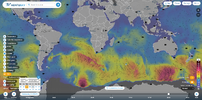
I checked the maximum wave height near the Antarctic coast and they are up to about 14 meters.
Considering a possible correlation with the positions of the Mid-Atlantic Ridge
The Mid-Atlantic ridge goes down through the Atlantic from North to South between the Americas and Europe/Africa. Here is a map that shows the tectonic plates from the Wiki on
Plate tectonics.

There is not a close match for the anomaly near Antarctica.
On the model, the ridge appears as a line, but it is not a simple line, and the ridge has fracture zones. The
Wiki explains:
Fracture zones are common features in the geology of oceanic basins. Globally most fault zones are located on
divergent plate boundaries on
oceanic crust. This means that they are located around
mid-ocean ridges and trend perpendicular to them. The term fracture zone is used almost exclusively for features on
oceanic crust; similar structures on
continental crust are instead termed
transform or strike slip faults.
For the Atlantic Ocean, there is this introduction:
In the Atlantic Ocean most fracture zones originate from the
Mid-Atlantic Ridge, which runs from north to south, and are therefore west to east oriented in general. There are about 300 fracture zones, with an average north-south separation of 55 kilometres (34 mi):
[6] two for each degree of latitude. Physically it makes sense to group Atlantic fracture zones into three categories:
[7]
- Small offset: length of transform fault less than 30 kilometres (19 mi)
- Medium offset: offset over 30 kilometers
- Large offset: offset several hundreds of kilometers
Looking up one example from the list there is about the
Verna Fracture Zone:
The
Vema Fracture Zone is a
fracture zone in the equatorial
Atlantic Ocean. It offsets the
Mid-Atlantic Ridge by 320 km to the left.
[1] Its
transform valley has a depth of 5000m. The fracture zone can be traced for over 2500 km east to west.
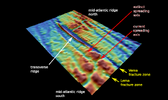
They do not all look like the above, the Wiki for the
Bouvet Triple Junction begins:
The
Bouvet Triple Junction is a geologic
triple junction of three
tectonic plates located on the seafloor of the South
Atlantic Ocean. It is named after
Bouvet Island, which lies 275 kilometers to the east.[
citation needed] The three plates which meet here are the
South American Plate, the
African Plate, and the
Antarctic Plate. The Bouvet Triple Junction although it appears to be a R-R-R type, that is, the three plate boundaries which meet here as
mid-ocean ridges: the
Mid-Atlantic Ridge (MAR), the
Southwest Indian Ridge (SWIR), and the
South American-Antarctic Ridge (SAAR) is actually slightly more complex
and in transition.[2]
[...]
There are two prominent transform valleys in the area: Conrad transform and Bouvet transform. Both transforms are named as
fracture zones.
[3] Conrad transform is named after
USNS Robert D. Conrad (T-AGOR-3).
[3] Bouvet Island is the highest point on the southern wall of the Bouvet transform and was formed 2.0–2.5 million years ago.
[4]

The complexity of the ocean floor with the many fracture zones and the geological variations within the
Earth's Crust, much of which is little explored due to the depth of the oceans, can explain the possibility that there are deep deposits of gas that under certain conditions can be released very suddenly and give rise to ocean swells. The energy for the swells would not be from so much from the wind as from the water being pushed by the upwelling gas. That the wave anomalies in the Southern Hemisphere tend to move mainly North needs an explanation. Is it related to the Earth-Moon system, the rotation of the Earth, or something else? It could be interesting to go through the archived data, month by month, and try to find out if there are any patterns. What can be explained by ordinary swells and what can't? Have there been other events, that were not reported?

